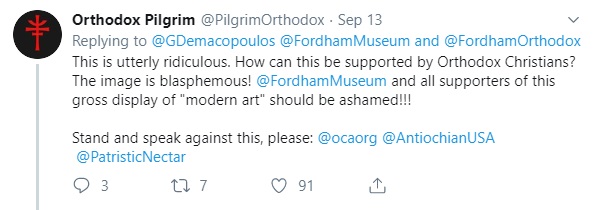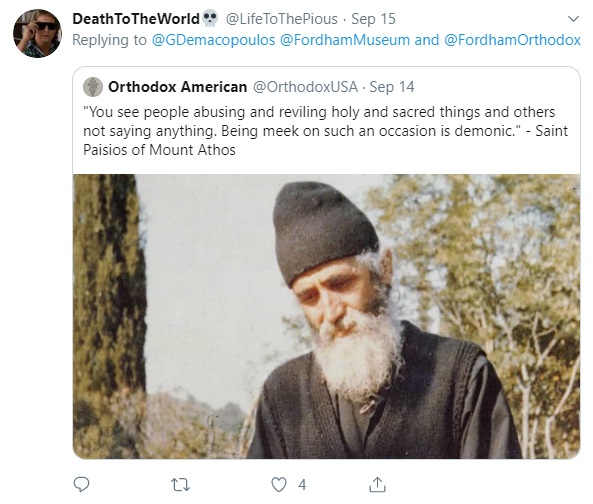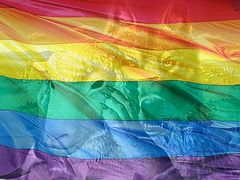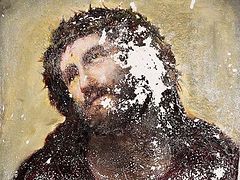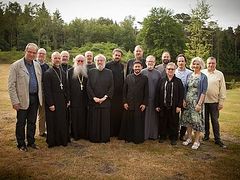New York, September 17, 2019
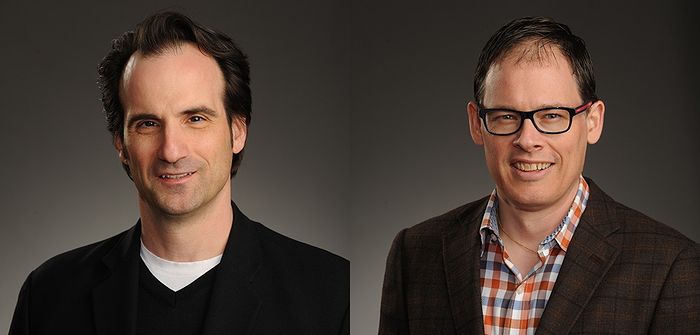 Aristotle Papanikolaou and George Demacopoulos of Fordham's Orthodox Christian Studies Center. Photo: news.fordham.edu
Aristotle Papanikolaou and George Demacopoulos of Fordham's Orthodox Christian Studies Center. Photo: news.fordham.edu
The museum at Fordham university in New York City launched a provocative new project on Thursday September 12 with the opening of its fall exhibit, “Distant Relatives: Ancient Imagery of the Classical Pagan Past and the Modern Byzantine Icons of Joni Zavitsanos.”
The Fordham Orthodox Christian Studies Center is no stranger to provocation and controversy. It publishes the blog “Public Orthodoxy,” that includes a number of articles that blatantly contradict the well-established Tradition of the Church on a number of issues, especially in the realm of gender and sexuality.
There is also a close connection between the Fordham Center and the Order of St. Andrew the Apostle, the Archons of the Ecumenical Patriarchate in America, as both George Demacopoulos and Aristotle Papanikolaou, the co-founders of the Center, are members, with Demacopoulos serving as the organization's official historian. The Archons recently announced the intentionally provocative decision to bestow a human rights award upon “Metropolitan” Epiphany Dumenko, the primate of the schismatic “Orthodox Church of Ukraine,” which is well-known as a persecutor of fellow Ukrainians in the canonical Ukrainian Church.
In a similar move, the Patriarchate of Constantinople aimed to provoke fellow Orthodox Christians by inviting another bishop of this violent “church” to a forum dedicated to combating hate crimes.
Scholars from Fordham and the University of Exeter also recently organized a conference in Oxford to discuss contemporary issues of sex, gender, and sexuality in relation to the Orthodox Church. In addition to clergy and scholars, featured speakers also included LGBTQ activists and a “vampire” drag show host.
According to the press service of the Archons, the artist, Joni Zavitsanos, is the wife of Archons National Council member John Zavitsanos, Esq., who was recently awarded for “Extraordinary Archon Stewardship,” and all Archons were officially invited to the opening.
The Archons describe Zavitsanos’ work: “Ms. Zavitsanos employs ancient and Byzantine motifs in her creation of uniquely contemporary art. Her work demonstrates how visual designs with roots in the distant past retain their relevance throughout time. She strives to use references to religious art from the 1st century to relate to a modern audience.”
An unofficial “announcement” also came from George Demacopoulos, who tweeted: “Very excited for tonight’s opening of the @FordhamMuseum exhibit of mixed-media Orthodox art. @FordhamOrthodox,” including an image of one of Zavitsanos’ pieces that shows a veiled woman with the word “Dirty” written on her forehead painted overtop a collage of 16 icons of the Theotokos.
Upon closer examination, it can also be seen that the image of Christ Himself has been removed from all the icons and replaced with images of children from around the world.
Unsurprisingly, such a provocative image did indeed provoke: Demacopoulos’ tweet collected more than 120 replies, the vast majority expressing sadness and disgust at the way icons were being used in Zavitsanos’ piece:

Several people responded by quoting St. Paisios the Athonite:
Several commenters simply noted that the image was blasphemous and disrespectful to Christ and the saints.
Others pointed out that it seemed Demacopoulos’ tweet was intended to cause just such a reaction:
While Demacopoulos himself doesn’t seem to have taken the time to respond to any of the many comments, several of his colleagues did. Aristotle Papanikolaou wrote, seemingly unconcerned by the disquiet caused among the faithful: “The comments reveal why the work of @FordhamOrthodox is so important. If these people represent all that Orthodoxy is, then the Church is in deep trouble.”
Brandon Gallaher, a professor of theology at the University of Exeter who has attended the liberal conferences on sexuality, responded by characterizing the responses as “absurd” and “sick reactionism.”
Katherine Kelaidis, who published a disturbing article on Public Orthodoxy comparing the practice of closed Communion to an eating disorder and who contributes to the equally troubling journal, The Wheel, responded: “I am going to go out on a limb and guess the Creator of the platypus probably has eclectic enough taste to be cool with this. Unlike some of the parochial members of His fan club gathered here in horror.”
Several users responded to let her know of the absurdity of her comparison.
Papanikolaou also responded: “The comments here are ridiculous. Bother to learn and ask questions before you condemn.” However, when another user responded: “Allow me to learn: what educational value is there in this? Allow me to ask: how do you respond to the claim that this art is irreverent and a desecration of holy icons?” Papanikolaou never answered.
In fact, it was left up to an unrelated user to post a link to Zavitsanos’ website where an explanation of the controversial image could be found. In a short audio clip, the artist explains that the woman with “Dirty” on her forehead is not the Theotokos, but St. Mary of Egypt, shown at the moment of her conversion.
“In place of Christ’s face,” Zavitsanos says, “there are children of various races and creeds, showing the universality of God’s love for all mankind.”
Of course, this is certainly a message preached by the Orthodox Church, but it seems many are scandalized at the way that Zavitsanos has shown to convey that message.
An icon of the Theotokos, with the Christ Child in her arms, is precisely an icon of the Incarnation of God the Word. It is in taking up the human nature that is common to all people, regardless of race or creed, that Christ shows His love for all mankind, and this is what is conveyed by an icon. Thus, it is unnecessary, and scandalizing, to remove Christ from an icon in order to demonstrate His own love.
Another piece being displayed at the museum shows an icon-like depiction of Christ, Who holds a sign that reads: “MAKE LOVE NOT WAR,” with a flower at the bottom left. The Ruler of All is thus brought down to the level of a touter of hippie slogans.
Another piece, not part of the museum exhibition but available on Zavitsanos’ website, is nothing short of blasphemous. The piece “Ruler of the Cosmos” evokes the domes in churches around the world that show Christ the Pantocrator; however, in Zavitsanos’ work, Patriarch Bartholomew of Constantinople has replaced Christ Himself.
He is “shown in the Heavens as our ruler who, while living with us on this earth, stands in the place of Christ and imitates Him,” the artist explains.
The exhibition runs through December 12. Zavitsanos will offer two lectures during its run.

